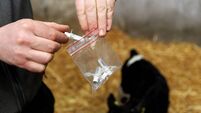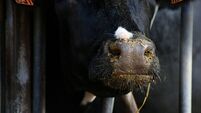Pilot scheme brings fast broadband delights to Belcarra

When a cow was close to calving, he’d ring his neighbour — a garage-owner — who’d close his business and walk 200m down to Conor’s farm to check on the cows. “On a day that a cow was unsettled, my neighbour would do that at least twice, because I’m gone from 8am to 5pm.”
It has changed since earlier this year, when Conor was one of 70 homes and businesses in Belcarra in rural Mayo to sign up for Eircom’s Fibre to the Home (FTTH) pilot project, which delivers high-speed (1GB) broadband.
“When Eircom put in the fibre, the first thing I did was get WiFi cameras. It’s very important to be able to monitor calving season. It meant getting practically perfect pictures to my iPhone at work. It’s like an eye in the sky. I can monitor the cows from a height, as opposed to standing on ground level looking across their backs. The quality is almost as good as going down to the yard and doing a physical check. I can zoom in close and really properly see what’s going on, and then intervene if needs be.”
Conor’s farm is split. He rents land 10 miles from the home farm. “When I’m there on Saturdays, I’m still able to monitor my cattle through the iPhone. And at 2am, with my cow in the calving box and a camera fixed on that area, I can put out my hand, take my iPhone, press an app, look at the cow and know she’s OK. My old routine was to check the calving cows once or twice during the night, depending on the cow. Now, in a matter of minutes, I have the cows properly checked and am back to sleep.”
The Government’s National Broadband Plan (NBP) is committed to delivering high-speed broadband of at least 30 megabits per second (30Mb/s) to every home and business in Ireland. The plan created a regulatory environment, stimulating commercial operators to invest in high-speed broadband provision to 70% of Ireland’s premises. State intervention is necessary to deliver it to the remaining 30% — about 700,000 properties. Most of this population live in low-density rural communities of one-off housing and ribbon-style development.
Eircom CEO Richard Moat has said the high-speed broadband rollout is the modern equivalent of the rural electrification programme.
With the NBP tender due to issue later this year, the company is hoping to emerge the winner. The Belcarra FTTH trial — available to 150 homes/businesses plus two national schools and one mart in the small farming community six miles south-east of Castlebar — is the showcase for Eircom’s proposed solution for delivering super fast broadband into the farthest reaches of rural Ireland.
“Belcarra, with its mart, school and community centre, all strung along the main street and with spurs off it, is representative of tons of communities all over Ireland,” says Carolan Lennon, MD of Eircom Wholesale.
In Belcarra, fibre has been connected directly to the home/business, eliminating copper lines from the network. Fibre can transfer huge amounts of data over long distances.
According to Lennon, with a 1GB broadband connection, rural consumers can download a high definition film in less than a minute. Business owners will have bandwidth capacity to transfer applications and large data files at rates previously only available to large enterprises. “What they have in Belcarra is comparable to the fastest broadband in the most high-tech part of the world.”
For the moment, the rest of rural Ireland can only look on with envy. Teagasc business and technology advisor Alan Nolan encourages farmers to do farm administration online. But he’s realistic. “Farmers get very frustrated with poor broadband, the slow speed, screens freezing. It’s a big barrier to moving online. Time is limited, they want to get their jobs done in an efficient way.”
In the last few weeks, Conor Heaney has started doing his calf registration online. “Prior to getting FTTH, the system was so slow. You could spend all night logging in. Now, within five minutes of starting the computer, I have two or three calves registered.”
He’s happy with the built-in system of checks that prevents errors. Doing calf registration manually, it was all too easy to make a mistake.
“You could be writing the card up in the shed with the wind blowing, the biro falls on the ground, you pick up the wrong card, and register the calf to the wrong cow. The card comes back to you within the week, and you’d have to do the whole thing again.”
Alan Nolan says extension of high-speed broadband will cut down the volumes of paperwork required of farmers, the bane of their lives in recent decades.
“They can maintain their herd register online. They can view maps of their farm. If they need to make adjustments for the Basic Payments Scheme, they can add or exclude a site online. Previously, if they’d started renting two fields down the road, or if they wanted to exclude a site which they’d given to their son to build a house, they’d have had to map it out themselves, draw it out, and send it off in the post.”
Nolan sees fibre on farms transforming the sector, with high-speed broadband opening up new possibilities.
For farmers who want to buy a stock bull or use AI, it will spell an end to going to bull sales or reading AI catalogues. Instead, they can quickly do their bull research on the Irish Cattle Breeding Federation website www.icbf.com
With ICBF’s HerdPlus programme, they can access a number of farm reports on their herd, like the beef calving report or the slaughter report — key performance indicators that will help them make improvements. “More of the marts are going online. A farmer could bring his cattle to the mart in the morning, go to his day job, and watch his cattle being sold online,” says Nolan.
In Belcarra, high-speed broadband means Conor Heaney’s wife, Anne (who, as a midwife, is required to regularly upskill) can now do refresher courses online. The couple have four children aged from 10 down to four.
“The kids are very excited about being able to stream movies and kids’ stuff using Netflix. The older girls use it a lot for school projects and research.”









